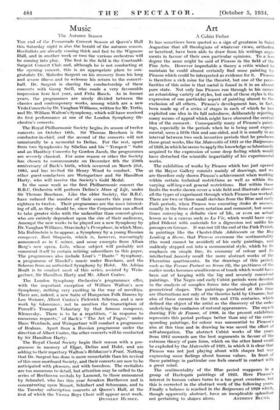Art
A Cubist Father
IT has sometimes been quoted as a sign of greatness in Saint Augustine that all theologians of whatever views, orthodox or heretical, have been able to draw from his writings argu- ments in favour of their own particular opinions. To a less degree the same might be said of Picasso in the field of the Fine Arts. However improbable a theory a critic wished to maintain he could almost certainly find some painting by Picasso which could be interpreted as evidence for it. Picasso is therefore a rich mine for the theorist, but one of the pecu- liarities of this mine is that metal is found in it in an almost pure state. Not only has Picasso run through in his career an astonishing variety of styles, but each of theie styles is the expression of one particular aspect of painting almost to the exclusion of all others. Picasso's development has, in fact, been made up of a series of stages in each of which he has exploited one idea in its full nakedness, deliberately rejecting many means of appeal which-might have obscured the central idea of the moment. Consequently many of Picasso's paint- ings, especially in the periods when he is being most experi- mental, seem a little thin and one-sided, and it is usually in an interval between two such inventive periods that he produces those great works, like the Maternites of 1921 or the Baigneuses of 1929, in which he seems to apply the knowledge so laboriously acquired to the expression of some deep feeling which would have disturbed the scientific impartiality of his experimental works.
The exhibition of works by Picasso which has just opened at the Mayor Gallery consists mainly of drawings, and we are therefore only shown Picasso's achievement when working within certain technical restrictions as well as within the varying self-imposed general restrictions. But within these limits the works shown cover a wide field and illustrate almost all the types of experiment through which Picasso has worked. There are two or three small sketches from the Blue and early Pink periods, when Picasso was executing etudes de meters, usually in the form of mere notation and comment, but some- times conveying a definite view of life, or even an actual lesson as in a canvas such as La Vie, which would have sup- plied Diderot with materials for a digression not unlike his passages on Greuze. It was not till the end of the Pink Period, in paintings like the Chester-Dale Adolescents or the Boy Leading a Horse, that Picasso overcame the sentimentality (the word cannot be avoided) of his early paintings, and suddenly stepped out into a 'monumental style, which by its emphasis on simple line, its economy of colour and its intellectual honesty recall the more abstract works of the Florentine quattrocento. In the drawings of this period. such as the Femme Portant un Sccau (3), the prettiness of the earlier works becomes sensitiveness of touch which would have been out of keeping with the big and severely conceived paintings. The Negro and early Cubist periods were devoted to the analysis of complex forms into the sirriplest possible geometrical shapes. The paintings produced at this time are illustrations not only of the theories held by Cezanne, but also of those current in the 16th and 17th centuries, which defined the object of the artist as the discovery of the ordir underlying the confusion of natural appearances. The stir erb drawing Tete de Femme, of 1908, in the present exhibition represents this period perhaps better than any of the corre- sponding paintings, for colour was unessential to Picasso's aim at this time and in drawing he was saved the effort of self-abnegation. The abstract Cubist works of the years from 1912 onwards are the best arguments in favour of the extreme theory of pure form, which on the other hand could be exploded by the Matcrnites of 1921, in which it is clear that Picasso was not just playing about with shapes but was expressing some feelings about human values. In front of these paintings in particular one feels oneself in contact with a great mind.
The sentimentality of the Blue period reappears in a group of Harlequin paintings of 1923. Here Picasso's interest in human values turns to a too great sweetness, but this is corrected in the abstract work of the following years. Finally a balance is reached in the Baigneuses of 1929 which, though apparently abstract, have an inexplicable splendour not pertaining to shapes alone. ANTHONY BLUNT.










































 Previous page
Previous page